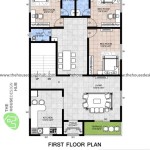How Can I Get a Floor Plan of My House?
Obtaining a floor plan of a house is often a crucial step in various home-related projects, from renovations and interior design to insurance claims and property appraisals. A floor plan provides a visual representation of a home's layout, including the dimensions of rooms, locations of walls, windows, doors, and other fixed elements. Knowing how to acquire or create a floor plan can save time, money, and potential headaches during home improvement endeavors or when managing property-related matters. Multiple avenues exist for obtaining a floor plan, each with its own advantages and disadvantages. Understanding these options allows homeowners to select the most suitable method for their specific needs and circumstances.
The availability of existing floor plans varies significantly depending on the age of the house, its location, and whether previous owners have undertaken renovations or expansions. Newer homes are more likely to have readily accessible floor plans, as building codes and permitting processes often require their creation and storage. Older homes, particularly those built before the widespread adoption of computer-aided design (CAD) software, may lack formal floor plans. In such cases, homeowners may need to resort to alternative methods, such as contacting local government agencies or creating their own floor plans manually or with the aid of digital tools.
The cost of obtaining a floor plan can also vary considerably. Some sources, such as local government offices, may provide access to existing plans for a nominal fee or even free of charge. However, hiring a professional architect or surveyor to create a new floor plan can be a more expensive option. The expense will be dependent on the size and complexity of the house and the level of detail required in the floor plan.
Checking Existing Records and Official Sources
The first step in obtaining a floor plan is to explore existing records. These records may already contain the floor plan, saving time and money. Several potential sources exist, ranging from local government agencies to previous owners and real estate agents.
Local Government Offices: Many municipalities require builders to submit floor plans and site plans as part of the building permit process. These plans are often archived at the local city hall, county recorder's office, or building department. Contacting these offices and inquiring about the availability of records for a specific property is a prudent first step. A property address or parcel number is usually needed to initiate the search. The plans, if available, may be accessible for a small fee or free of charge, depending on the jurisdiction.
Previous Owners or Real Estate Agents: Reaching out to previous owners of the property or the real estate agent who handled the sale can also be productive. They might have copies of the floor plan from when the house was built or when it was last sold. Contact information for previous owners may be available through property records or neighborhood associations. Real estate agents often retain marketing materials, including floor plans, for a period after a sale.
Mortgage and Title Companies: Mortgage companies and title insurance companies might have a copy of an appraisal report that includes a basic floor plan. While these floor plans are usually not as detailed as architectural drawings, they can provide a general overview of the house's layout and dimensions. Reviewing mortgage documents or contacting the title company that handled the property transaction could lead to the discovery of an existing floor plan.
It is crucial to thoroughly investigate all potential sources before resorting to creating a new floor plan. The cost and effort involved in obtaining an existing plan are typically lower than those associated with creating a new one. Moreover, existing plans are more likely to accurately reflect the original construction of the house.
Creating a Floor Plan Manually
If existing floor plans are unavailable, creating a new one is necessary. This can be done manually using measuring tools, paper, and drafting supplies. While this method requires time and attention to detail, it can be a cost-effective option, especially for those with some drafting experience.
Essential Tools and Materials: The basic tools for manual floor plan creation include a measuring tape (preferably a long one), a pencil, an eraser, graph paper, a straightedge, and a protractor. A laser measure can significantly improve accuracy and speed up the measuring process. A notebook or clipboard is also useful for recording measurements and making notes.
Measuring Rooms and Features: Begin by sketching a rough outline of the house's exterior walls. Then, systematically measure each room, noting the lengths of walls, the positions of doors and windows, and the locations of any built-in features such as fireplaces, closets, and cabinets. Measure each wall multiple times to ensure accuracy. Pay particular attention to corners and angles, as inaccuracies in these areas can lead to cumulative errors in the final floor plan. Record all measurements clearly and legibly.
Drawing the Floor Plan to Scale: Once all measurements have been collected, transfer them to the graph paper. Choose a suitable scale (e.g., 1/4 inch equals 1 foot) and carefully draw the walls, doors, windows, and other features to scale. Use the straightedge and protractor to ensure that lines are straight and angles are accurate. Double-check all measurements and drawings as the floor plan takes shape. Correcting errors early in the process is easier than making adjustments later.
Adding Details: After the basic layout is complete, add details such as the locations of electrical outlets, light fixtures, and plumbing fixtures. Indicate the direction of door swings and the types of windows. Label each room clearly and add dimensions to the walls. Consider adding notes about ceiling heights and any other relevant information.
Manual floor plan creation can be a rewarding experience for those who enjoy hands-on projects. However, it is important to be patient and meticulous. Accuracy is essential for creating a useful and reliable floor plan. If precise measurements and drawings are critical, using digital tools or hiring a professional is recommended.
Using Digital Tools and Software
Digital tools and software provide a more efficient and accurate way to create floor plans. These tools range from user-friendly mobile apps to professional-grade CAD software. They offer features such as automatic measurement conversions, drag-and-drop elements, and the ability to create 3D models.
Mobile Apps for Floor Plan Creation: Several mobile apps are designed specifically for creating floor plans. These apps typically use the device's camera and sensors to measure rooms and create floor plans automatically. Some popular options include Magicplan, RoomScan Pro, and Floor Plan Creator. These apps often offer features such as augmented reality (AR) measurement, automatic scaling, and the ability to export floor plans in various formats. While these apps can be convenient and easy to use, their accuracy may vary depending on the device and the environment. It is important to calibrate the app and take multiple measurements to ensure the best results.
Online Floor Plan Software: Online floor plan software offers a more comprehensive set of features than mobile apps. These programs typically run in a web browser and allow users to create floor plans using a drag-and-drop interface. Some popular options include SmartDraw, Lucidchart, and RoomSketcher. These programs often offer libraries of symbols for doors, windows, furniture, and other elements. They also allow users to add dimensions, labels, and notes to their floor plans. Online floor plan software is generally more accurate than mobile apps and offers more flexibility in terms of design and customization. However, they may require a subscription fee or a one-time purchase.
CAD Software for Professional Use: For those who require highly accurate and detailed floor plans, CAD software is the best option. CAD programs, such as AutoCAD and Revit, are used by architects, engineers, and designers to create technical drawings and models. These programs offer a wide range of features for creating precise floor plans, including advanced measurement tools, parametric design capabilities, and the ability to generate 3D models. CAD software is more complex to learn and use than mobile apps or online floor plan software. However, it provides the highest level of accuracy and control. Professional training or experience is often required to use CAD software effectively.
Choosing the right digital tool depends on the user's skill level, budget, and the required level of accuracy and detail. Mobile apps are suitable for quick and simple floor plans, while online floor plan software is a good option for more complex projects. CAD software is the best choice for professionals who need to create highly accurate and detailed floor plans.
Hiring a Professional Architect or Surveyor
Engaging a professional architect or surveyor is the most accurate and reliable method for obtaining a floor plan. While this option is typically more expensive than creating a floor plan manually or using digital tools, it ensures that the floor plan is accurate, detailed, and meets all relevant building codes and regulations.
Benefits of Hiring a Professional: Professional architects and surveyors have the expertise and equipment to accurately measure and document a house's layout. They use specialized tools such as laser scanners and total stations to create precise floor plans. They also have a thorough understanding of building codes and regulations, which can be important for renovation projects. A professional floor plan can be used for a variety of purposes, including obtaining building permits, planning renovations, and documenting the property for insurance purposes.
Finding a Qualified Professional: To find a qualified architect or surveyor, seek referrals from friends, family, or colleagues. Check online directories and professional organizations, such as the American Institute of Architects (AIA) or the National Society of Professional Surveyors (NSPS). Review the professional's portfolio and references to assess their qualifications and experience. Obtain quotes from multiple professionals and compare their fees and services.
The Process of Creating a Professional Floor Plan: The process of creating a professional floor plan typically involves an initial consultation, followed by a site visit. During the site visit, the architect or surveyor will measure the house's exterior and interior, noting the locations of walls, doors, windows, and other features. They may also take photographs and create a rough sketch of the floor plan. After the site visit, the architect or surveyor will create a detailed floor plan using CAD software. This floor plan will typically include dimensions, labels, and notes, as well as information about building materials and construction techniques. The floor plan will be provided to the homeowner in a digital format, such as a PDF or DWG file.
Hiring a professional architect or surveyor is a wise investment for those who require a highly accurate and detailed floor plan. The benefits of professional expertise and accuracy outweigh the higher cost, especially for complex renovation projects or when legal or regulatory compliance is required.

How Do I Get A Floor Plan For My Property

Floor Plan Creator And Designer Free Easy App

House Plans How To Design Your Home Plan

House Plans How To Design Your Home Plan

9 Ways To Find Floor Plans Of An Existing House Blueprints Archid

Draw Floor Plans With The Roomsketcher App

House Plans How To Design Your Home Plan

Designing My Own House

House Plans How To Design Your Home Plan

Floor Plan Creator And Designer Free Easy App
Related Posts








